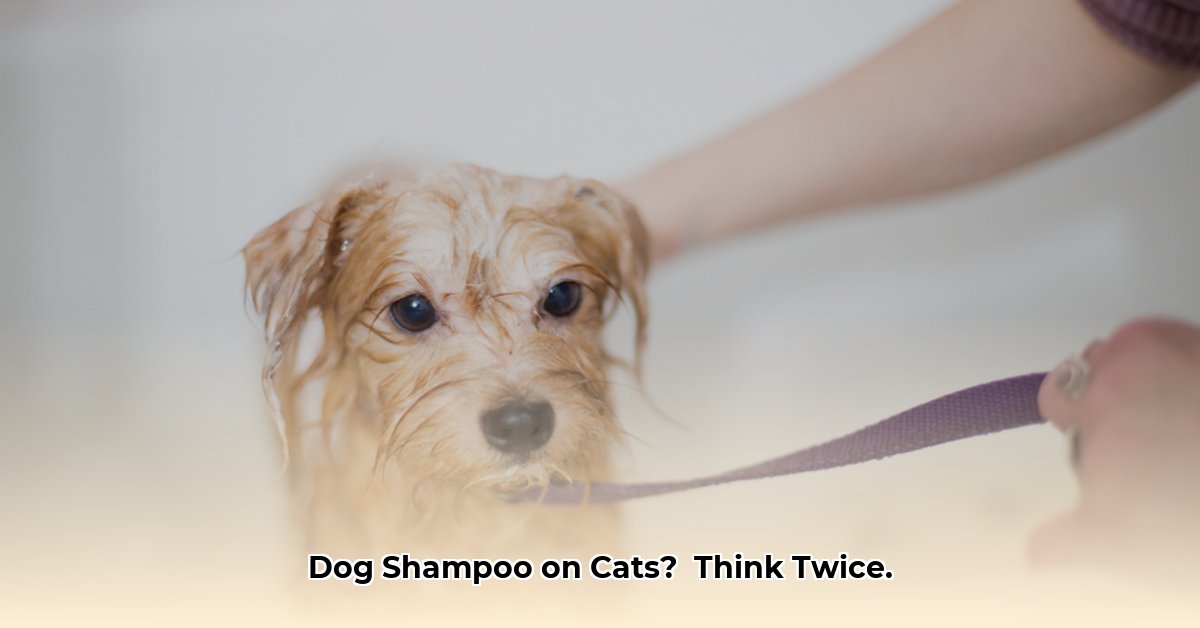No. Dog shampoo is generally not safe for cats. While it might seem convenient to grab any shampoo when bath time rolls around, using dog shampoo on your cat can lead to skin irritation and even more serious health problems. This is due to key differences in the pH levels of cat and dog skin, as well as the presence of certain ingredients toxic to cats in many dog shampoos.
Why Dog Shampoo Shouldn’t Be Used on Cats
Several factors make dog shampoo unsuitable for felines:
Skin pH Differences
A cat’s skin is naturally more acidic than a dog’s. This acidity helps maintain a healthy skin barrier that protects against bacteria, parasites, and environmental irritants. Dog shampoos are formulated for a dog’s more alkaline skin pH. Using a dog shampoo on a cat disrupts this delicate balance, stripping away vital oils and increasing the risk of dryness, itching, inflammation, and infections. It’s similar to using a harsh detergent on delicate fabric – it can damage the material and make it more susceptible to wear and tear.
Toxic Ingredients
Many dog shampoos contain ingredients that are toxic to cats. Permethrin, a common insecticide in flea and tick shampoos for dogs, is particularly dangerous. Even small amounts of permethrin can cause severe neurological problems in cats, including tremors, seizures, and in some cases, death. Some essential oils, while seemingly natural and harmless, can also be toxic to cats due to their different metabolic pathways. Cats lack certain liver enzymes needed to process some of these oils, which can then accumulate and cause harm. Always scrutinize ingredient lists and avoid using any product on your cat that contains permethrin, tea tree oil, or other essential oils known to be toxic to felines.
Risks of Using Dog Shampoo on Cats
The consequences of using dog shampoo on a cat can range from mild to severe:
- Skin Irritation: Dryness, itching, redness, and flaking are common reactions to the disrupted skin pH and harsh ingredients in dog shampoos.
- Infections: The compromised skin barrier makes cats more susceptible to bacterial and fungal infections.
- Permethrin Poisoning: Symptoms can include tremors, seizures, excessive salivation, vomiting, difficulty breathing, and loss of coordination. If you suspect permethrin poisoning, contact your veterinarian or an animal poison control center immediately.
- Essential Oil Toxicity: Depending on the oil and the level of exposure, symptoms can vary. Lethargy, loss of appetite, vomiting, tremors, and difficulty walking are possible signs.
What to Do If You Accidentally Use Dog Shampoo on Your Cat
If you’ve already used dog shampoo on your cat, don’t panic, but do act quickly:
- Rinse: Thoroughly rinse your cat with plenty of lukewarm water to remove all traces of the shampoo.
- Observe: Monitor your cat closely for any unusual signs, such as those listed above.
- Contact Your Vet: If you notice any symptoms or are concerned, contact your veterinarian immediately. Provide them with the name of the dog shampoo used.
Safe Alternatives for Bathing Your Cat
Fortunately, there are several safe and effective alternatives to dog shampoo:
| Alternative | Description |
|---|---|
| Cat Shampoo | Formulated specifically for feline skin and fur, maintaining the proper pH balance. |
| Hypoallergenic Dog Shampoo (labeled as safe for cats) | A gentler option; always verify the label to ensure it’s feline-friendly. |
| Unscented Baby Shampoo | Can be used sparingly as a last resort, but it’s not ideal for regular use. |
| Plain Water | Often sufficient for lightly soiled cats, offering a chemical-free cleaning option. |
How to Bathe a Cat Safely
Bathing a cat can be a challenge, but these tips can make it easier:
- Gather Supplies: Cat shampoo, towels, a pitcher or cup for rinsing, a rubber mat, and treats.
- Prepare the Bath: Fill a sink or basin with lukewarm water.
- Introduce Your Cat Gently: Gradually acclimate them to the water.
- Apply Shampoo: Lather a small amount of shampoo, avoiding the face and eyes.
- Rinse Thoroughly: Ensure no shampoo residue remains.
- Dry: Towel dry or use a hairdryer on a low, cool setting if your cat tolerates it.
- Positive Reinforcement: Reward your cat with treats and praise.
Kitten-Specific Considerations
Kittens are especially sensitive. Consult your vet before bathing a kitten. If a bath is necessary, use a kitten-specific shampoo or plain warm water and be extra gentle. Ensure the kitten stays warm during and after the bath.
Additional Tips and Considerations
- Frequency: Cats generally require infrequent bathing, typically only when visibly dirty or have a specific skin condition. Over-bathing can strip away essential oils and irritate the skin.
- Grooming: Regular brushing is often sufficient to keep a cat clean.
- Waterless Shampoos: These are an option for cats who strongly dislike water.
- Consult Your Veterinarian: For any questions or concerns about your cat’s health or grooming needs, always consult your veterinarian. They can provide personalized advice and recommendations.
While this guide provides comprehensive information, ongoing research in veterinary dermatology may lead to new insights and recommendations. Always consult your veterinarian for the most up-to-date advice regarding your cat’s specific needs.
- Bento Box Trays Streamline Restaurant Meal Presentation and Transport - December 13, 2025
- Plastic Bento Boxes Face Scrutiny Over Sustainability Impacts - December 11, 2025
- Bento Tray Revolutionizes Organized Meal Transport and Presentation - December 10, 2025










